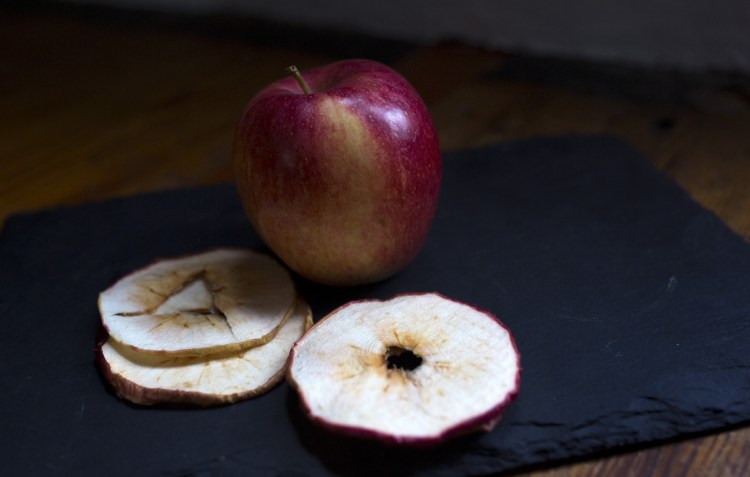As a general life rule, I don’t pass up apple cider doughnuts. They don’t come around all that often, I reason, so it’s best to have one when you see one, especially if they are warm.
While I waited in line at the Applewald Farm stall in the Brunswick Winter Market last weekend, I noticed small packages of dried McIntosh apples on offer between the doughnuts and the jugs of apple cider. Sliced thinly, rubbed with lemon juice to keep browning at bay, and dehydrated is just one of many ways a Maine apple farmer can productize a crop to create wintertime cash flow.
I bought a bag and was happy to have them to munch on once the doughnut was gone. But as I was eating this locally sourced dried fruit I began to chew on the fact that all of the others varieties in my cupboard – apricots, dates, figs, prunes and raisins – that play pretty heavily into my wintertime cooking come from California. The tart cherries I love come from Oregon and my cranberries from wherever the Ocean Spray cooperative sources them.
The traditionally air-dried (as opposed to freeze-dried) fruit market is a global one. According to a report released earlier this year by the International Nut and Dried Fruit Council, world-wide production of dried fruit stands at 3.5 billion pounds. Turkey and Iran produce the most; the United States is a close third. In the United States, raisins comprise about 63 percent of dried fruit production; prunes about 28 percent; and, dates, figs and apricots amount to roughly six, three and less than one percent, respectively.

From left, dried cranberries are paired with walnuts, dried figs with hazelnuts and dried apricots with pistachios for Goat Cheese and Dried Fruit Truffles.
In terms of food miles, the same amount of fossil fuel is required to truck in a pound of fresh apricots from California to Maine as is needed to bring us a pound of dried apricots. But the former requires energy-sucking refrigeration and the later does not. And by volume, there are 8-12 fresh apricots to a pound while there are over 60 dried ones to a pound. Therefore, the energy required per dried apricot to get it to this coast is significantly lower than it is for its fresh counterpart. But since commercial dried fruit companies rarely dry their fruit in the sun, energy is expended to dry them. The council’s report also tracks the sustainability practices of dried fruit production world-wide and reported the renewable energy sources such as hydro-electric and solar power were widely employed in U.S. operations, a good sign that dried fruit stands as the greener option for Mainers in wintertime.
On the consumption side of the sustainability question, the flavor of dried fruit is more concentrated, so an eater may be sated with a handful and only a small amount is required to get the desired result in a recipe. Unlike moist fresh fruits, dried fruit can produce a more concentrated pie filling that won’t bubble out of its pastry case while baking. They are also high in natural sugars so you can use them as sweet counterpoints in savory holiday appetizers. And dried fruit has useful binding powers that help hold nuts and seeds together to make those low-sugar but high-protein energy bars you’ll need when you make it back to the gym once the holidays are over.
ABOUT THE WRITER
CHRISTINE BURNS RUDALEVIGE is a food writer, recipe developer and tester and cooking teacher in Brunswick, and the author of “Green Plate Special,” a cookbook from Islandport based on these columns. She can be contacted at cburns1227@gmail.com.
Send questions/comments to the editors.


